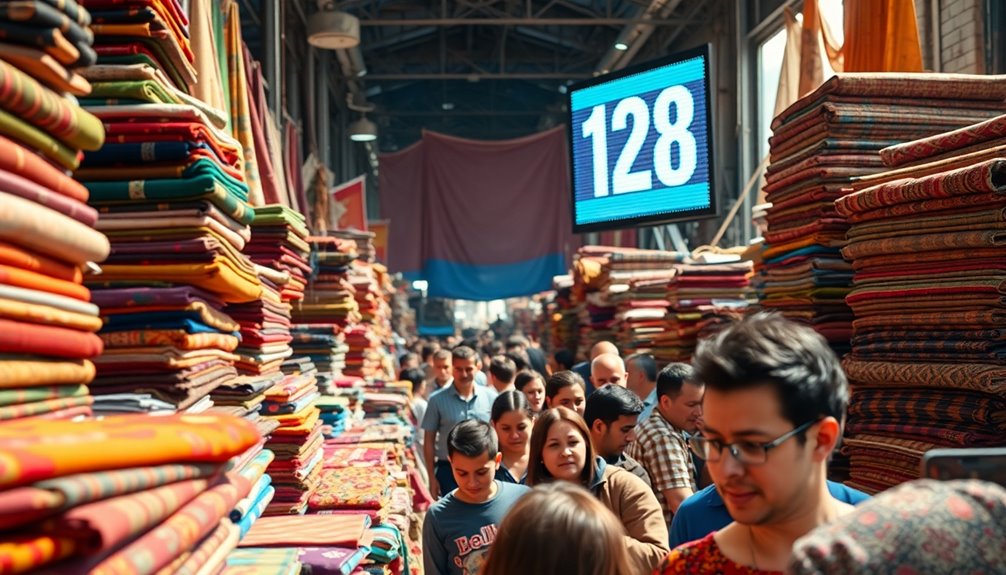Turkiye's fabric import data for 2024 shows an impressive 20% increase in imports from Malaysia, reaching $128 million despite an overall decline in total imports. You'll find that this significant rise indicates a shift in supplier dynamics within the market. While traditional suppliers face challenges, Malaysia's competitive pricing and strategic positioning are boosting its presence. If you're curious about the factors affecting these trends further, there's much more to explore.
Key Takeaways
- Turkiye's cotton fabric imports in 2024 totaled 134 million square meters, a 21% decline from 2023.
- Imports from Malaysia rose by 20%, reaching $128 million amidst overall declining import trends.
- Major suppliers traditionally include Pakistan, Turkmenistan, China, and Egypt, highlighting shifting dynamics in the market.
- Economic factors such as inflation and reduced demand for garments are impacting Turkiye's textile sector.
- The increase from Malaysia suggests competitive pricing and strategic positioning within the fabric import landscape.

In the first three quarters of 2024, Turkiye's cotton fabric imports dropped to 134 million square meters, marking a significant decline of about 21% compared to the same period last year. Despite this overall decrease, you'll find a notable increase from Malaysia, which saw a 20% rise in fabric imports, totaling $128 million. This contrasting trend highlights the complexities within the fabric import market, where certain suppliers manage to thrive even as overall demand wanes.
Turkiye's cotton fabric imports fell 21% in 2024, yet Malaysia's imports surged 20%, revealing market complexities.
The major suppliers of cotton fabric to Turkiye have traditionally included Pakistan, Turkmenistan, China, and Egypt. However, Malaysia's growing presence indicates a shift in market dynamics. While the domestic and international markets grapple with reduced demand for apparel and garments, Malaysia's strategic positioning and competitive pricing may have contributed to its rising share in Turkiye's import landscape. This shift occurs amid Türkiye's economic growth expectations to rise to 3% in 2025, which may influence future import patterns.
Economic challenges play a significant role in shaping these trends. Turkiye's economy has faced hurdles, with growth slowing to 2.7% in 2024, though an uptick to 3% is expected in 2025. High inflation and import costs continue to undermine the competitiveness of Turkiye's textile industry. The global recession and political uncertainties further complicate the situation, leading to fluctuations in both imports and exports.
You should also consider the broader implications of these changes. Major export destinations for Turkish textiles, like Italy, Germany, and the US, have also seen a decline in apparel exports by 11.1% in early 2024. These developments suggest that while certain markets like Malaysia show promise, the overall outlook for Turkiye's textile sector remains fraught with challenges.
In response to these market shifts, industry players are exploring sustainability initiatives and marketing strategies to bolster growth. Events like the Carpet and Flooring Expo and Viptex Fashion B2B meetings aim to attract attention and investment, even as companies start to look at lower-cost countries like Egypt for future opportunities.
Frequently Asked Questions
What Types of Fabric Does Turkiye Primarily Import From Malaysia?
When you look at Turkiye's fabric imports from Malaysia, you'll find a variety of types.
Primarily, you'll see cotton and polyester fabrics, which are popular for their versatility and durability.
Linen fabrics also make the list, appreciated for their breathability.
Additionally, blended fabrics cater to specific textile needs.
Specialty fabrics for industrial use are included too, showcasing the diverse preferences in Turkiye's textile market.
How Does This Increase Impact Malaysia's Textile Industry?
A surge in sales signals significant success for Malaysia's textile industry.
This increase in fabric imports strengthens your economic landscape, boosting export revenues and job opportunities.
With rising global demand, your industry can thrive, attracting investments and fostering innovation.
As local manufacturers adapt, they'll benefit from government support and collaboration.
Are There Any Tariffs on Fabric Imports From Malaysia?
Yes, there are tariffs on fabric imports from Malaysia, but they've been significantly reduced.
Under the MTFTA, many textile products enjoy immediate elimination of additional customs duties, enhancing your competitiveness in the Turkish market.
However, ensure you meet the specific Rules of Origin requirements to qualify for these preferential duties.
Keep in mind that some products may still face regular tariffs, so check the Exclusion List carefully.
What Are the Main Reasons for the Import Increase?
Imagine a bustling marketplace where vibrant fabrics dance in the breeze, showcasing their colors.
This increased import surge from Malaysia springs from trade agreements that cut costs, currency shifts making fabrics appealing, and rising demand in your textile industry.
Plus, improved logistics boost efficiency, while Malaysian fabrics meet quality needs.
Diversifying sources strengthens your supply chain, ensuring you're not tethered to just one supplier, enhancing your market resilience and creativity.
How Do These Figures Compare to Previous Years' Imports?
When you compare the current import figures to previous years, you'll notice significant fluctuations.
For instance, Turkiye's fabric imports have generally risen due to changes in global demand and trade agreements.
In 2023, imports from certain regions surged, indicating a trend towards increased reliance on diverse fabric sources.
This growth reflects the evolving textile market, highlighting how economic factors and regional trade dynamics shape import volumes over time.
Conclusion
You might think a 20% increase in fabric imports from Malaysia is just a number, but it highlights a vital shift in trade dynamics. This surge to $128 million signals not only growing demand but also the strengthening of international partnerships. As Turkiye expands its fabric market, you'll want to keep an eye on how this impacts the local industry and global trends. Embracing this change could unlock exciting opportunities for innovation and collaboration in the fabric sector.










